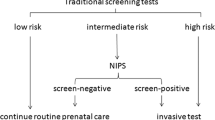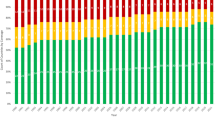Abstract
On practical terms we can say that prenatal diagnosis (PND) only started in Portugal in 1984 after the Abortion Act was approved by Parliament. Since then the demand for PND has been increasing, but we realise that the coverage of high-risk pregnancies as well as screening for fetal abnormalities in the general population are below the desirable levels. Among the factors that contribute to this we can mention the bad planning in some services, the low standard of ultrasound scans in the low-risk pregnancies, the small number of public cytogenetics laboratories performing fetal karyotyping, the scarcity of genetic counsellors and last but not least the inadequate limit of 16 weeks for termination of pregnancies in case of fetal malformation.
Similar content being viewed by others
Introduction
Although occasional prenatal diagnoses (PND) were done in Portugal since the late 70s, it was only after the 1984 Abortion Act that PND was really implemented in the country. The first Prenatal Diagnosis Centre based on a multidisciplinary approach was created 11 years ago in the north of Portugal (Porto-IGM/CHG). Since then, independent genetic clinics, genetic laboratories and obstetric departments have been collaborating to complement each other in a multidisciplinary way.
At this stage, to cover a country with a population of 10 million and a birth rate of approximately 115,000/year, we have: 8 cytogenetic laboratories (6 public and 2 private), 4 molecular laboratories (public), 2 biochemical laboratories (metabolic diseases) (public) and 5 genetic clinics (public).
Sources of Information
Data relevant to PND are collected at a national level since 1992 by the State Department of Health. It includes: the number of genetic counselling sessions prior to fetal sampling, the indications for PND specifying the different ages defined as ‘advanced maternal age’, the different types of laboratories where the samples were processed and also the laboratories outside the country to which biological samples were sent. It also includes the qualifications of the laboratory staff involved in PND, and who gives the result to the couple. Data on abortions due to the various invasive techniques, the number of affected fetuses and the number of terminations of pregnancies are also collected. Our National Registry of Congenital Anomalies (which includes anomalies detected until the end of the first month of life) started in January 1996. At the regional level there has been a Registry of Congenital Anomalies since 1992 that is limited to the central region of Portugal.
Different regions of the country are also contributing to EUROCAT and EUROFETUS. There are no other databases, and the only existing group is the Portuguese Prenatal Diagnosis Association, which was created in 1995.
Impact of Prenatal Diagnosis
As stated before, we have no national registries which would allow us to evaluate the impact of PND on the prevalence of chromosomal disorders and severe congenital malformations. We can only state that we offer PND for the standard chromosomal indications; as far as advanced maternal age is concerned, some centres offer amniocentesis (AC) to women aged 35 and over and others only to women of 38 and over. However, we know that AC covers approximately 30% of the pregnancies at risk for chromosome abnormalities.
Regarding the psychosocial impact of PND, we can say that in spite of the fact that our coverage rate is still below the desirable level, we have noticed a steady annual increase of the awareness and demand for PND not only in the high-risk group but also in the general population.
Unfortunately, pretest counselling is not done in all cases, but when it is done it is generally the responsibility of the clinical geneticist or the obstetrician. The same professionals are responsible for counselling after a positive finding.
Despite the majority of the Portuguese population being catholics, couples who come for PND generally agree on termination of pregnancy if the fetus is severely affected. Support after termination of pregnancy is offered to the couple by a psychologist or even a psychiatrist if necessary. Fortunately, in a study done in our country on the psychological reactions of pregnant women to termination of pregnancy for fetal abnormality, no severe psychological sequelae were found.
Available Diagnostic Procedures
Fetal karyotyping is available in 5 of the 6 public laboratories and in the 2 private laboratories. Biochemical serum screening: there are no regional or national screening programmes for biochemical markers; screening is performed by some private laboratories and some hospitals. Ultrasound screening is available and offered to all pregnant women. In low-risk pregnancies, an ultrasound examination is recommended at 16–20 weeks of gestation to screen for abnormalities. In the high-risk pregnancies, the number of ultrasound examinations is not limited. Molecular diagnosis: the following conditions can be diagnosed in utero: Duchenne-Becker muscular dystrophies, spinal muscular atrophies, fragile X, Angelman-Prader-Willi syndrome, familial amyloid neuropathy, cystic fibrosis, haemoglobinopathies, haemophilia A and B, X-linked immunodeficiency with hyper-IgM, Lowe oculocerebrorenal syndrome, Norrie disease, and protein S deficiency.
Some PND of metabolic disorders are complemented with molecular studies. Comment: due to the relatively low frequency of some of these conditions, the small number of molecular laboratories and the scarse resources of our country, a non-official agreement was made so that each laboratory has a different ‘task’. Although there are no established guidelines, the following indications for PND are generally accepted:
-
(1)
Indications for PND which require fetal sampling:
-
— maternal age ≥ 35 years (in some centres only after 38 years of age);
-
— previous child with Down’s syndrome or any other chromosome abnormality;
-
— parent carrier of a chromosome abnormality;
-
— previous child or affected parent with a monogenic disease;
-
— X-linked conditions;
-
— abnormal ultrasound findings;
-
— positive biochemical screening test.
-
-
(2)
Indications for PND by high resolution ultrasound
-
— previous child, affected parent or close relative with a polygenic or multifactorial condition;
-
— previous child with unexplained mental retardation or congenital malformations;
-
— previous child or affected parent with specific monogenic disease (e.g. skeletal problems);
-
— consanguinity.
-
Current Methods in Use for Prenatal Diagnosis
AC, usually done between 13 and 16 weeks of gestation, accounts for 95.7% of fetal sampling. It is performed in various obstetric departments both at the central and the regional level. Amniofiltration has been occasionally performed since 1992. It is only done in one main centre and normally between 11 and 12 weeks of gestation. Chorionic villus sampling is only performed in a small percentage of cases (1.3%). Patients are referred to the few centres where the clinicians have some experience in the procedure. Chordocentesis is also limited to a few obstetric departments and accounts for 3% of fetal sampling.
Table 1 shows the distribution of the different fetal sampling techniques for 1992, 1993 and the first 9 months of 1994. As mentioned previously, we only have data on a national basis after 1992.
The different methods of fetal sampling are offered according to the type of pathology, time of gestation, the risk of having an affected child and also taking into consideration the couple’s choice. Unfortunately there are no professional guidelines either for obstetricians or for cytogeneticists. Since 1995, science graduates who are contemplating a carreer in genetics, have to go through a 3-year training period which includes cytogenetics, biochemistry and molecular genetics.
Areas under Development
Interphase fluorescence in situ hybridisation (FISH) is used in some laboratories in specific cases, and a few comparative studies with conventional chromosome results in AC are in progress. Metaphase FISH is also done as complementary investigations in special cases. First-trimester biochemical screening is under trial in one private laboratory under the surpervision of a United States laboratory.
First-trimester ultrasound scans are mainly done in some obstetric centres.
Funding Arrangements for Prenatal Diagnosis
The great majority of the Portuguese population is covered by a medical aid scheme of the National Health System which pays for almost all the PND testing. Private insurances are practically non-existent in Portugal.
The absence of official guidelines for PND in Portugal sometimes leads to misuse of prenatal testing.
Current Legislation Surrounding Prenatal Diagnosis
The current legislation, passed in 1984, only allows termination of pregnancy until the 16th week of gestation in case of severe fetal malformation. However, the law does not define ‘severe’ malformation.
There is no legislation for pre-implantation diagnosis.
Present Problems and the Future
Present Problems
-
— Bad planning of the different services, with difficulties in communication between clinician/laboratory and genetic services/obstetric departments.
-
— Low coverage of the high-risk pregnancies, not only in the cases of women of 38 and over, but also in those with other increased genetic risks.
-
— Despite the Department of Health recommending and paying for at least one ultrasound scan at 16–20 weeks in all low-risk pregnancies, a great percentage of those scans are of low standard;
-
— lack of cytogenetic laboratories and difficulties in the prenatal diagnosis of intra-uterine infections;
-
— impossibility at this stage to offer biochemical screening to all pregnant women on a national or regional level;
-
— a considerable number of fetal sampling is performed without previous counselling and unfortunately there are some obstetric departments which perform invasive techniques and afterwards refuse to terminate the pregnancy when indicated;
-
— the inadequate limit of 16 weeks for termination of pregnancy in the presence of congenital abnormalities.
Future
A national working group was formed in 1995 that is trying to overcome some of these problems.
The objectives are:
-
(1)
to define criteria for PND, to increase the offer, public awareness and demand;
-
(2)
to implement quality control in ultrasound scans and to increase the capacity of cytogenetic laboratories;
-
(3)
to offer first-trimester ultrasound to all pregnant women in the near future;
-
(4)
to offer biochemical screening to all pregnant women under 35 years within the next 3–5 years.
-
(5)
alteration of the current legislation on termination of pregnancy — ideally up to 24 weeks.
Author information
Authors and Affiliations
Addendum
Addendum
On the 20th of February 1997 Parliament approved an amendment to the 1984 Abortion Act, which now allows termination of pregnancies for severe fetal abnormality up to the 24th week of gestation, and no limit in cases of pathology incompatible with life.
Rights and permissions
About this article
Cite this article
Pinto, M.R., Fortuna, A.M.T. Prenatal Diagnosis in Portugal. Eur J Hum Genet 5 (Suppl 1), 61–63 (1997). https://doi.org/10.1007/BF03405964
Issue Date:
DOI: https://doi.org/10.1007/BF03405964



